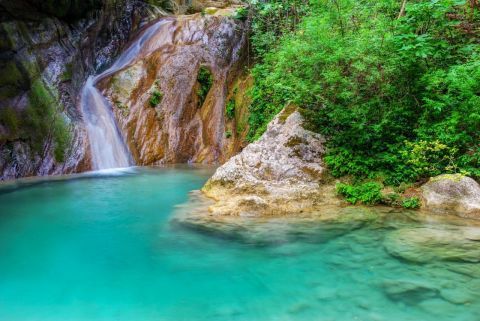Ancient Lefkada
Ancient Lefkada in Greece: The island's name has derived from Lefkas Petra (white stone), which happens to be a prehistoric name of today's Lefkada, located in the southern part of the island. The southern cape, which is conspicuous by its white rocky promontories is where the poet Sappho gave away her life for the sake of love, which in turn provides the name to the city.
The city of Lefkada was brought into existence by the Corinthians and with the passage of time, the entire island was referred to in the same name. Renowned geographer Stravonas is of the opinion that the prehistoric city of Nirikos was renamed Lefkada and was made to function as the capital of the island by the Corinthians.
Human habitation in Lefkada goes back to the Paleolithic era. The German archaeologist Wilhelm Dairepfeld in association with Heinrich Schliemann who took part in the Troy excavations carried out a wide-ranging archaeological investigation at Nidri, which offered a fascinating insight into the ancient city of Lefkada thanks to remnants from the Copper Age dating back to 2000 BC.
The prehistoric city of Nirikos, which dates back to the 7th century BC, was discovered by archaeologists in Kalligoni and historians are unanimous in their opinion that it was the island's original capital. A massive wall encircled it. Nowadays, only a part of the wall is left and the major portion of the wall has been destructed due to the wrath of nature.
Back in the 7th century BC, Lefkada was once a key Corinthian colony until the Roman conquest. It was politically linked to the city of Corinthos. The city of Lefkada provided assistance in tumultuous events like the battle of Salamina, the battle of Platea and the Peloponnesian War as a trusted partner of the Spartans. It also offered military assistance during the conquest of Alexander the Great.
The city of Lefkada showed tremendous resistance to the Romans during the 3rd century B.C., before ultimately surrendering to them in the 2nd century. During the Roman regime, numerous important projects were undertaken, including the stone bridge that linked the island with Akarnania and the reconstruction of the ancient wall.
After the Fourth Crusade (1204), Lefkada became part of the Despotate of Epirus. However, in 1294, Lefkada came under Frankish rule, as Despot Nikephoros I Komnenos Doukas, the ruler of Epirus, bestowed it as a gift to his son-in-law, John I Orsini. He is credited for building the foundation of the Agia Mavra Castle, which is located at the entrance of the island.
Later on, the island of Lefkada was under the rule of the royal Tocco family. The last of the Tocci, Leonardo the Third, is reported to have assisted the Venetians against the mighty Turks. Nevertheless, Venice ceded with the Turks who later went on to capture Lefkada and banished Leonard away. In 1500, new disputes came to the surface between them and the Venetians captured the island only to give it back to the Turks a year later.
The Venetians again had the opportunity to rule over Lefkada from 1684 till 1797. After that, it was the turn of the French to rule over the island. A year later the island was captured by the combined might of the Russian-Turkish navy and became an integral part of the Heptanesian State.
In 1810, it was the turn of the Britishers to rule over the island. They ruled until 1864, when during the reign of George I of Greece, Lefkada and the rest of the Ionian Islands were annexed to the Greek State.
The island prospered for a few years thanks to the flourishing of trade. However, a grapevine disease destroyed the island's vineyards, a fact that led several inhabitants to despair. This is when an emigration wave towards America and Canada started, which lasted until the end of World War II.
Fortunately, the island started to recover gradually and is now in a peaceful state.



